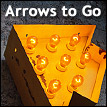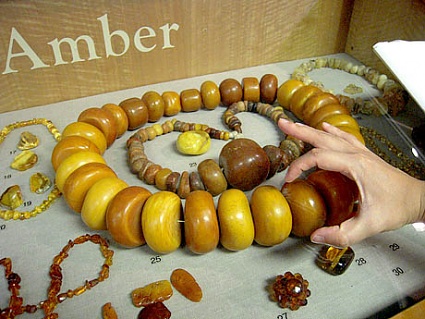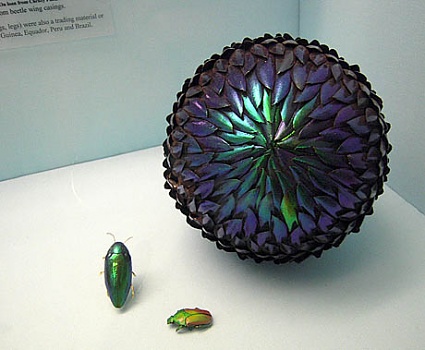During a phone interview with The Arizona Republic yesterday, I discovered that the state's unusual little Bead Museum, which boasted a reportedly world-class collection of ornamental roundness, was shut down last year. And it reminded me of my own brief, and fruitless, visit to the establishment during one of my research trips for Weird Arizona.
Turns out, the museum wasn't much interested in my interest in them, but I used the opportunity to write a little something about them anyway. However, the resultant pair of articles, a spotlight piece and a personal account of my visit, which I wrote together in 2006, were never published. So, in honor of the now lost assembly of orbs, I present them here.
The Bead Museum
Beads: those little globes of joy. Beads: the tiny, colored spheres that ornament our lives. Beads: orbs of emotion that bring us both delight and sorrow. Beads, beads, beads!
They're everywhere. They surround us. We use them in our curtains, our rosary and our macramé vests. They comprise our necklaces, our Christmas-tree garland and those massage mats cab drivers use. Hair braids, flogging whips, erotic toys, bedazzled sweatpants ... we can't escape beads!
Large and small, wooden and plastic, clear and opaque: you'll find them all at the Bead Museum. Thousands of beads and beaded artifacts from all over the world make up the collection, all neatly arranged in glass cases in this odd little museum in downtown Glendale.
Their beads come from Tibet, Afghanistan, Morocco. Beads of shell, beads of coral, beads of banana leaf and monkey fur. Sometimes they're cubed. They even sneak in a few baubles. Is that cheating? Hey, it's all from the gewgaw family!
Curators cover bead usage in the form of currency, ornamentation and ancient religious artifacts. Exhibits review more than 30,000 years of bead history with displays like "Not to Worry: Prayer Beads, Rosaries and Talismans," "The Language of Beads" and "Incredible Polymer: Feats of Clay." In "Beadwork II: The Embellished Shoe," Beadwork Magazine showcased footwear, though some say the sequel wasn't as good as the original.
Pop in and see the exhibits; maybe even attend a lecture or a workshop. Take a class and learn how to make a Tubular Ndebele Necklace or a Dutch Spiral. Just be sure to stop by the gift shop on your way out. They have beads there.
Maybe They Didn't Trust My Beady Eyes
I love museums dedicated entirely to trivial objects. Somehow, anything that's otherwise completely dull becomes absurdly fascinating when gathered in quantity and placed under glass. It's just too bad this museum's beadkeepers were completely disinterested in my visit.
I stood in the gift shop, the only visitor in the museum, and waited to be helped. The two employees behind the counter ignored my presence and continued rearranging their trays of beads. When I finally got someone's attention, I explained how I'd be happy to include their museum in Weird Arizona and asked if I could take a few pictures while I was there. Beadkeeper #1 asked Beadkeeper #2 what she thought. Beadkeeper #2 knocked on an office door and passed the question on to Beadkeeper #3. That's right — it takes three people to run a museum about beads.
B3 told B2 they'd have to ask B's 4 and 5 — correction: it takes five people to run a museum about beads — and they wouldn't be back till Monday. B2 relayed this to B1 as if I weren't standing right there and B1 repeated it all back to me.
I expressed my disappointment and explained I wouldn't be in town that long. But they were already back to their bead trays, without another word to say. Obviously, dividing balls of plastic by color requires a great deal of focus. I paused a few moments for a response, then left. I was never even offered a ticket for admittance. No friendship bracelets for these three. But I guess they can make their own.
The Bead Museum closed in March 2011. Its 11,650 beads and beaded items were donated to the Mingei International Museum in San Diego, California.





